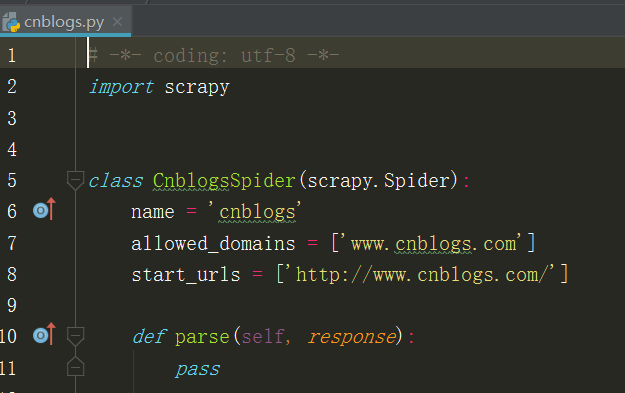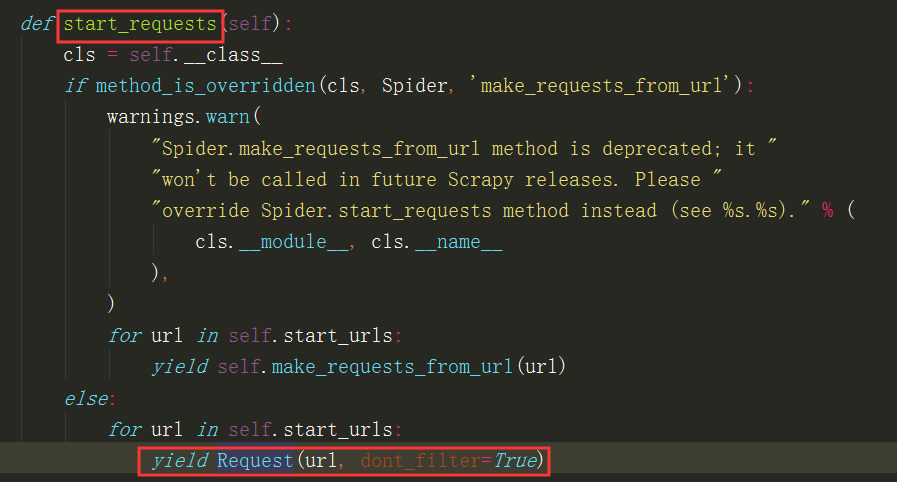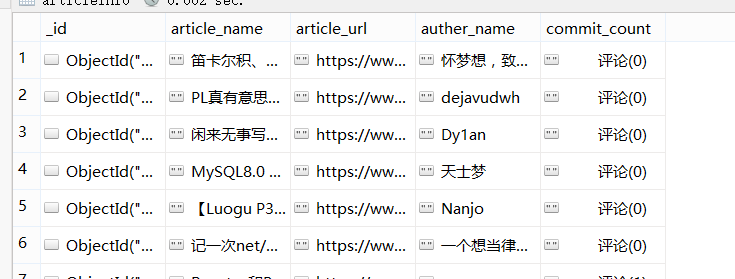Scrapy框架——介绍、安装、命令行创建,启动、项目目录结构介绍、Spiders文件夹详解(包括去重规则)、Selectors解析页面、Items、pipelines(自定义pipeline)、下载中间件(Downloader Middleware)、爬虫中间件、信号
一 介绍
Scrapy一个开源和协作的框架,其最初是为了页面抓取 (更确切来说, 网络抓取 )所设计的,使用它可以以快速、简单、可扩展的方式从网站中提取所需的数据。但目前Scrapy的用途十分广泛,可用于如数据挖掘、监测和自动化测试等领域,也可以应用在获取API所返回的数据(例如 Amazon Associates Web Services ) 或者通用的网络爬虫。
Scrapy 是基于twisted框架开发而来,twisted是一个流行的事件驱动的python网络框架。因此Scrapy使用了一种非阻塞(又名异步)的代码来实现并发。整体架构大致如下
第五步的Response会到spiders类中parser函数中解析

- 引擎(EGINE)
引擎负责控制系统所有组件之间的数据流,并在某些动作发生时触发事件。有关详细信息,请参见上面的数据流部分。
- 调度器(SCHEDULER)
用来接受引擎发过来的请求, 压入队列中, 并在引擎再次请求的时候返回. 可以想像成一个URL的优先级队列, 由它来决定下一个要抓取的网址是什么, 同时去除重复的网址 - 下载器(DOWLOADER)
用于下载网页内容, 并将网页内容返回给EGINE,下载器是建立在twisted这个高效的异步模型上的 - 爬虫(SPIDERS)
SPIDERS是开发人员自定义的类,用来解析responses,并且提取items,或者发送新的请求 - 项目管道(ITEM PIPLINES)
在items被提取后负责处理它们,主要包括清理、验证、持久化(比如存到数据库)等操作 - 下载器中间件(Downloader Middlewares) 在此可以使用代理池和cookie池
位于Scrapy引擎和下载器之间,主要用来处理从EGINE传到DOWLOADER的请求request,已经从DOWNLOADER传到EGINE的响应response,你可用该中间件做以下几件事- process a request just before it is sent to the Downloader (i.e. right before Scrapy sends the request to the website);
- change received response before passing it to a spider;
- send a new Request instead of passing received response to a spider;
- pass response to a spider without fetching a web page;
- silently drop some requests.
- 爬虫中间件(Spider Middlewares) 可以在此做去重等功能
位于EGINE和SPIDERS之间,主要工作是处理SPIDERS的输入(即responses)和输出(即requests)
二、安装(可以先试着第一步安装scrapy,看能不能装上,不行再一步步安装其他的)
#Windows平台
1、pip3 install wheel #安装后,便支持通过wheel文件安装软件,wheel文件官网:https://www.lfd.uci.edu/~gohlke/pythonlibs
3、pip3 install lxml
4、pip3 install pyopenssl
5、下载并安装pywin32:https://sourceforge.net/projects/pywin32/files/pywin32/
6、下载twisted的wheel文件:http://www.lfd.uci.edu/~gohlke/pythonlibs/#twisted
7、执行pip3 install 下载目录\Twisted-17.9.0-cp36-cp36m-win_amd64.whl
8、pip3 install scrapy #Linux平台
1、pip3 install scrapy
三、命令行工具
#1 查看帮助
scrapy -h
scrapy <command> -h #2 有两种命令:其中Project-only必须切到项目文件夹下才能执行,而Global的命令则不需要
Global commands:
startproject #创建项目
genspider #创建爬虫程序
settings #如果是在项目目录下,则得到的是该项目的配置
runspider #运行一个独立的python文件,不必创建项目
shell #scrapy shell url地址 在交互式调试,如选择器规则正确与否
fetch #独立于程单纯地爬取一个页面,可以拿到请求头
view #下载完毕后直接弹出浏览器,以此可以分辨出哪些数据是ajax请求
version #scrapy version 查看scrapy的版本,scrapy version -v查看scrapy依赖库的版本
Project-only commands:
crawl #运行爬虫,必须创建项目才行,确保配置文件中ROBOTSTXT_OBEY = False
check #检测项目中有无语法错误
list #列出项目中所包含的爬虫名
edit #编辑器,一般不用
parse #scrapy parse url地址 --callback 回调函数 #以此可以验证我们的回调函数是否正确
bench #scrapy bentch压力测试 #3 官网链接
https://docs.scrapy.org/en/latest/topics/commands.html
示范用法 (重点******)只要就是三个标红的步骤
#1、执行全局命令:请确保不在某个项目的目录下,排除受该项目配置的影响
scrapy startproject MyProject 创建项目 cd MyProject
scrapy genspider baidu www.baidu.com 创建爬虫 scrapy settings --get XXX #如果切换到项目目录下,看到的则是该项目的配置 scrapy runspider baidu.py scrapy shell https://www.baidu.com
response
response.status
response.body
view(response) scrapy view https://www.taobao.com #如果页面显示内容不全,不全的内容则是ajax请求实现的,以此快速定位问题 scrapy fetch --nolog --headers https://www.taobao.com scrapy version #scrapy的版本 scrapy version -v #依赖库的版本 #2、执行项目命令:切到项目目录下
scrapy crawl baidu 启动项目
scrapy check
scrapy list
scrapy parse http://quotes.toscrape.com/ --callback parse
scrapy bench
1.创建项目 scrapy startproject myproject

2.新建爬虫 ,创建出一个爬虫文件
cd myproject
scrapy genspider cnblogs(爬虫名) www.cnblogs.com(爬取的域名)


3.执行项目
scrapy crawl cnblogs(爬虫名) --nolog (加上--nolog就不会打印日志了,不会打印出错误信息,建议最好打印,不写--nolog)

注意:默认只能在cmd中执行爬虫,如果想在pycharm中执行需要做,根目录创建main.py,然后启动main.py文件就行
#在项目目录下新建:main.py
from scrapy.cmdline import execute
execute(['scrapy', 'crawl', 'cnblogs'])
四、项目结构以及爬虫应用简介
project_name/
scrapy.cfg
project_name/
__init__.py
items.py
pipelines.py
settings.py
spiders/
__init__.py
爬虫1.py
爬虫2.py
爬虫3.py
文件说明:
- scrapy.cfg 项目的主配置信息,用来部署scrapy时使用,爬虫相关的配置信息在settings.py文件中。
- items.py 设置数据存储模板,用于结构化数据,类似于Django的Model
- pipelines 数据处理行为,如:一般结构化的数据持久化
- settings.py 配置文件,如:递归的层数、并发数,延迟下载等。强调:配置文件的选项必须大写否则视为无效,正确写法USER_AGENT='xxxx'
- spiders 所有爬虫程序,类似Django的app 如:创建文件,编写爬虫规则,请求页面,解析页面
- middlewares.py 中间件
五、Spiders文件夹详解
1、介绍
#1、Spiders是由一系列类(定义了一个网址或一组网址将被爬取)组成,具体包括如何执行爬取任务并且如何从页面中提取结构化的数据。 #2、换句话说,Spiders是你为了一个特定的网址或一组网址自定义爬取和解析页面行为的地方
2、Spiders会循环做如下事情 (重点******)
#1、生成初始的Requests来爬取第一个URLS,并且标识一个回调函数
第一个请求定义在start_requests()方法内默认从start_urls列表中获得url地址来生成Request请求,默认的回调函数是parse方法。回调函数在下载完成返回response时自动触发 #2、在回调函数中,解析response并且返回值(返回值就类似于请求页面的html,需要接着继续解析页面,解析页面在parse函数中完成)
返回值可以4种:
包含解析数据的字典
Item对象
新的Request对象(新的Requests也需要指定一个回调函数,继续放到下一次请求去解析)
或者是可迭代对象(包含Items或Request) #3、在回调函数中解析页面内容
通常使用Scrapy自带的Selectors,但很明显你也可以使用Beutifulsoup,lxml或其他你爱用啥用啥。(通常解析使用css,xpath这些方式) #4、最后,针对返回的Items对象将会被持久化到数据库
通过Item Pipeline组件存到数据库:https://docs.scrapy.org/en/latest/topics/item-pipeline.html#topics-item-pipeline)
或者导出到不同的文件(通过Feed exports:https://docs.scrapy.org/en/latest/topics/feed-exports.html#topics-feed-exports)
3.Spiders总共提供了五种类:
#1、scrapy.spiders.Spider #scrapy.Spider等同于scrapy.spiders.Spider
#2、scrapy.spiders.CrawlSpider
#3、scrapy.spiders.XMLFeedSpider
#4、scrapy.spiders.CSVFeedSpider
#5、scrapy.spiders.SitemapSpider
4.导入使用
import scrapy
from scrapy.spiders import Spider,CrawlSpider,XMLFeedSpider,CSVFeedSpider,SitemapSpider class AmazonSpider(scrapy.Spider): #自定义类,继承Spiders提供的基类
name = 'amazon' #爬虫名,必须唯一
allowed_domains = ['www.amazon.cn'] #允许的域名
start_urls = ['http://www.amazon.cn/'] #起始路由 def parse(self, response):
pass
查看源码:从Spider中进去
在Spider类中找到start_requests函数,这个就是爬虫的入口

for循环取出start_urls中的路由地址,Request请求地址,并且默认parse作为回调函数,把response放入parse函数中解析
5.class scrapy.spiders.Spider (这个等同于scrapy.Spider)
这是最简单的spider类,任何其他的spider类都需要继承它(包含你自己定义的)。
该类不提供任何特殊的功能,它仅提供了一个默认的start_requests方法默认从start_urls中读取url地址发送requests请求,并且默认parse作为回调函数
class AmazonSpider(scrapy.Spider):
name = 'amazon'
allowed_domains = ['www.amazon.cn']
start_urls = ['https://www.amazon.cn/'] def parse(self, response):
pass
定制scrapy.Spider属性与方法 (这些属性和方法都在Spider源码中)
#1、name = 'amazon' (******)
定义爬虫名,scrapy会根据该值定位爬虫程序
所以它必须要有且必须唯一(In Python 2 this must be ASCII only.) #2、allowed_domains = ['www.amazon.cn'] (******)
定义允许爬取的域名,如果OffsiteMiddleware启动(默认就启动),
那么不属于该列表的域名及其子域名都不允许爬取
如果爬取的网址为:https://www.example.com/1.html,那就添加'example.com'到列表. #3、start_urls = ['http://www.amazon.cn/'] (******)
如果没有指定url,就从该列表中读取url来生成第一个请求 #4、custom_settings
值为一个字典,定义一些配置信息,在运行爬虫程序时,这些配置会覆盖项目级别的配置
所以custom_settings必须被定义成一个类属性,由于settings会在类实例化前被加载 #5、settings
通过self.settings['配置项的名字']可以访问settings.py中的配置,如果自己定义了custom_settings还是以自己的为准 #6、logger
日志名默认为spider的名字
self.logger.debug('=============>%s' %self.settings['BOT_NAME']) #5、crawler:了解
该属性必须被定义到类方法from_crawler中 #6、from_crawler(crawler, *args, **kwargs):了解
You probably won’t need to override this directly because the default implementation acts as a proxy to the __init__() method, calling it with the given arguments args and named arguments kwargs. #7、start_requests() (爬虫的入口)
该方法用来发起第一个Requests请求,且必须返回一个可迭代(yield)的对象。它在爬虫程序打开时就被Scrapy调用,Scrapy只调用它一次。
默认从start_urls里取出每个url来生成Request(url, dont_filter=True) #针对参数dont_filter,请看自定义去重规则 #默认是去重的 如果你想要改变起始爬取的Requests,你就需要覆盖这个方法,例如你想要起始发送一个POST请求,如下
class MySpider(scrapy.Spider):
name = 'myspider' def start_requests(self):
return [scrapy.FormRequest("http://www.example.com/login",
formdata={'user': 'john', 'pass': 'secret'},
callback=self.logged_in)] def logged_in(self, response):
# here you would extract links to follow and return Requests for
# each of them, with another callback
pass#8、parse(response)
这是默认的回调函数,所有的回调函数必须返回an iterable of Request and/or dicts or Item objects. #9、log(message[, level, component]):了解
Wrapper that sends a log message through the Spider’s logger, kept for backwards compatibility. For more information see Logging from Spiders. #10、closed(reason)
爬虫程序结束时自动触发
去重规则:去除重复的url (一般都是使用scrapy自带的去重就足够了,看情况使用自定义的去重规则)
方法一:
把url放在集合中去重
方法二:
scrapy自带去重功能 RFPDupeFilter
from scrapy.dupefilters import RFPDupeFilter
只需要我们指定Request(...dont_filter=False)(默认是False),如果dont_filter=True则告诉scrapy这个URL不参与去重。(******)
仿照RFPDupeFilter自定义去重规则
from scrapy.dupefilters import RFPDupeFilter,看源码,仿照BaseDupeFilter
步骤一:在项目根目录下创建自定义去重文件dupefilters.py
from scrapy.dupefilters import BaseDupeFilter
#自己定制去重方案
class MyDupeFilter(BaseDupeFilter): def __init__(self, path=None, debug=False):
self.aa=set() def request_seen(self, request): #自定义去重规则在这个函数中写
if request.url in self.aa:
return True def close(self, reason):
pass def log(self, request, spider): #日志
pass 步骤二:配置文件settings.py
DUPEFILTER_CLASS = '项目名.dupefilters.MyDupeFilter' #具体路径看你这个文件的位置在哪
自定义去重规则需要注意两点:1.request_seen中编写去重的正确逻辑 2.在Resquest中写dont_filter=False (******)
BloomFilter去重(布隆过滤器 了解)
参数传递
我们可能需要在命令行为爬虫程序传递参数,比如传递初始的url,像这样
#命令行执行
scrapy crawl myspider -a category=electronics #在__init__方法中可以接收外部传进来的参数
import scrapy class MySpider(scrapy.Spider):
name = 'myspider'def __init__(self, category=None, *args, **kwargs):
super(MySpider, self).__init__(*args, **kwargs)
self.start_urls = ['http://www.example.com/categories/%s' % category]
#...
#注意接收的参数全都是字符串,如果想要结构化的数据,你需要用类似json.loads的方法
六、Selectors
parse解析时候使用css和xpath
#1 //与/
#2 text
#3、extract与extract_first:从selector对象中解出内容
#4、属性:xpath的属性加前缀@
#4、嵌套查找
#5、设置默认值
#4、按照属性查找
#5、按照属性模糊查找
#6、正则表达式
#7、xpath相对路径
#8、带变量的xpath
response.selector.css()
response.selector.xpath()
可简写为
response.css()
response.xpath() #1 //与/
response.xpath('//body/a/')#
response.css('div a::text') >>> response.xpath('//body/a') #开头的//代表从整篇文档中寻找,body之后的/代表body的儿子
[]
>>> response.xpath('//body//a') #开头的//代表从整篇文档中寻找,body之后的//代表body的子子孙孙
[<Selector xpath='//body//a' data='<a href="image1.html">Name: My image 1 <'>, <Selector xpath='//body//a' data='<a href="image2.html">Name: My image 2 <'>, <Selector xpath='//body//a' data='<a href="
image3.html">Name: My image 3 <'>, <Selector xpath='//body//a' data='<a href="image4.html">Name: My image 4 <'>, <Selector xpath='//body//a' data='<a href="image5.html">Name: My image 5 <'>] #2 text
>>> response.xpath('//body//a/text()')
>>> response.css('body a::text') #3、extract与extract_first:从selector对象中解出内容
>>> response.xpath('//div/a/text()').extract()
['Name: My image 1 ', 'Name: My image 2 ', 'Name: My image 3 ', 'Name: My image 4 ', 'Name: My image 5 ']
>>> response.css('div a::text').extract()
['Name: My image 1 ', 'Name: My image 2 ', 'Name: My image 3 ', 'Name: My image 4 ', 'Name: My image 5 '] >>> response.xpath('//div/a/text()').extract_first()
'Name: My image 1 '
>>> response.css('div a::text').extract_first()
'Name: My image 1 ' #4、属性:xpath的属性加前缀@
>>> response.xpath('//div/a/@href').extract_first()
'image1.html'
>>> response.css('div a::attr(href)').extract_first()
'image1.html' #4、嵌套查找
>>> response.xpath('//div').css('a').xpath('@href').extract_first()
'image1.html' #5、设置默认值
>>> response.xpath('//div[@id="xxx"]').extract_first(default="not found")
'not found' #4、按照属性查找
response.xpath('//div[@id="images"]/a[@href="image3.html"]/text()').extract()
response.css('#images a[@href="image3.html"]/text()').extract() #5、按照属性模糊查找
response.xpath('//a[contains(@href,"image")]/@href').extract()
response.css('a[href*="image"]::attr(href)').extract() response.xpath('//a[contains(@href,"image")]/img/@src').extract()
response.css('a[href*="imag"] img::attr(src)').extract() response.xpath('//*[@href="image1.html"]')
response.css('*[href="image1.html"]') #6、正则表达式
response.xpath('//a/text()').re(r'Name: (.*)')
response.xpath('//a/text()').re_first(r'Name: (.*)') #7、xpath相对路径
>>> res=response.xpath('//a[contains(@href,"3")]')[0]
>>> res.xpath('img')
[<Selector xpath='img' data='<img src="data:image3_thumb.jpg">'>]
>>> res.xpath('./img')
[<Selector xpath='./img' data='<img src="data:image3_thumb.jpg">'>]
>>> res.xpath('.//img')
[<Selector xpath='.//img' data='<img src="data:image3_thumb.jpg">'>]
>>> res.xpath('//img') #这就是从头开始扫描
[<Selector xpath='//img' data='<img src="data:image1_thumb.jpg">'>, <Selector xpath='//img' data='<img src="data:image2_thumb.jpg">'>, <Selector xpath='//img' data='<img src="data:image3_thumb.jpg">'>, <Selector xpa
th='//img' data='<img src="data:image4_thumb.jpg">'>, <Selector xpath='//img' data='<img src="data:image5_thumb.jpg">'>] #8、带变量的xpath
>>> response.xpath('//div[@id=$xxx]/a/text()',xxx='images').extract_first()
'Name: My image 1 '
>>> response.xpath('//div[count(a)=$yyy]/@id',yyy=5).extract_first() #求有5个a标签的div的id
'images'
示例
七、Items (类似于django的model)
示例:
import scrapy class ArticleItem(scrapy.Item):
article_name = scrapy.Field()
article_url = scrapy.Field()
auther_name = scrapy.Field()
commit_count = scrapy.Field()
八、pipelines (数据持久化,保存进数据库)
保存到数据库中大致流程:在parse中解析获取到的数据,要保存到数据库中就yield item对象,如果要继续爬就yield request对象。在pipelines中设置保存的数据库,yield item对象把数据存入到数据库中。配置文件配置pipelines
示例代码:
items.py (类似于创建的models类)
import scrapy class ArticleItem(scrapy.Item):
article_name = scrapy.Field()
article_url = scrapy.Field()
auther_name = scrapy.Field()
commit_count = scrapy.Field()
spiders 爬虫parse函数解析存储数据
def parse(self, response):
div_list = response.css('.post_item') #获取每篇文章
for div in div_list:
url=div.css('.post_item_body a::attr(href)').extract_first()
article_name=div.css('.titlelnk::text').extract_first()
auther_name=div.css('.post_item_foot a::text').extract_first()
commit_count=div.css('.post_item_foot span a::text').extract_first()
article_item=ArticleItem() #定义的items
#把地址存入数据库,yield item对象
article_item['article_name']=article_name
article_item['article_url']=url
article_item['auther_name']=auther_name
article_item['commit_count']=commit_count
yield article_item #需要yield item对象才会存入到pipelines存入数据库 next_url = response.css('.pager a:last-child::attr(href)').extract_first()
print('https://www.cnblogs.com'+next_url)
#dont_filter=True 表示不去重,默认去重
yield Request('https://www.cnblogs.com'+next_url) #继续请求下一页爬取数据
pipelines.py (设置存储到mogodb数据库中)
from pymongo import MongoClient
class ArticleMongodbPipeline(object):
def process_item(self, item, spider):
#连接
client = MongoClient('localhost', 27017)
#创建article数据库,如果没有叫创建,如果有,叫使用
db = client['article']
#如果有使用articleinfo,如果没有,创建这个表
article_info=db['articleinfo']
article_info.insert(dict(item)) #插入item数据,可以使用insert或者save方法
# article_info.save({'article_name':item['article_name'],'aritcle_url':item['article_url']})
# 如果retrun None ,下一个就取不到item了,取到的就是None
settings.py (配置pipelines,数字越小的越先执行)(注意这个一定要记得配置)(******)
ITEM_PIPELINES = {
'myproject.pipelines.ArticleMongodbPipeline': 300, #数字越小越先执行
}
爬取的数据

自定义pipeline
一:可以在pipeline.py中写多个Pipeline类
1、如果优先级高的Pipeline的process_item返回一个值或者None,会自动传给下一个pipline的process_item,
2、如果只想让第一个Pipeline执行,那得让第一个pipline的process_item抛出异常raise DropItem()
3、可以用spider.name == '爬虫名' 来控制哪些爬虫用哪些pipeline
代码示例:
#1、settings.py (settings中配置数据库的信息)
HOST="127.0.0.1"
PORT=27017
USER="root"
PWD=""
DB="amazon"
TABLE="goods" ITEM_PIPELINES = {
'Amazon.pipelines.CustomPipeline': 200,
} #2、pipelines.py
class CustomPipeline(object):
def __init__(self,host,port,user,pwd,db,table):
self.host=host
self.port=port
self.user=user
self.pwd=pwd
self.db=db
self.table=table
#获取配置数据库信息
@classmethod
def from_crawler(cls, crawler): #通过from_crawler控制类的创建过程
"""
Scrapy会先通过getattr判断我们是否自定义了from_crawler,有则调它来完成实例化,如果类中有这个函数会先执行这个函数,来控制类的创建过程
"""
HOST = crawler.settings.get('HOST') #从settings配置文件中获取数据库信息
PORT = crawler.settings.get('PORT')
USER = crawler.settings.get('USER')
PWD = crawler.settings.get('PWD')
DB = crawler.settings.get('DB')
TABLE = crawler.settings.get('TABLE')
return cls(HOST,PORT,USER,PWD,DB,TABLE) #类实例化走__init__方法
def open_spider(self,spider): #创建数据库链接
"""
爬虫刚启动时执行一次
"""
self.client = MongoClient('mongodb://%s:%s@%s:%s' %(self.user,self.pwd,self.host,self.port)) def close_spider(self,spider): #数据库连接关闭
"""
爬虫关闭时执行一次
"""
self.client.close() def process_item(self, item, spider): #进行持久化操作,写入数据库(相当于mogodb数据库中insert步骤)
# 操作并进行持久化 self.client[self.db][self.table].save(dict(item)) #return返回值如果是item,下一个pipeline能继续能到,如果return None,下一个拿不到
九.Downloader Middleware 下载中间件
下载中间件的用途:
提供在爬虫过程中修改Request和Response,用于扩展scrapy的功能
1、在process_request内,自定义下载中间件。
2、对请求进行二次加工,比如
设置请求头
设置cookie
添加代理
scrapy自带的代理组件:
from scrapy.downloadermiddlewares.httpproxy import HttpProxyMiddleware
from urllib.request import getproxies
3、在请求之后,回包需要解压等处理
编写自定义下载中间件
class DownMiddleware1(object):
def process_request(self, request, spider):
"""
请求需要被下载时,经过所有下载器中间件的process_request调用,优先级越高的中间件越先调用
:param request:
:param spider:
:return:
None,继续后续中间件去下载;
Response对象,停止process_request的执行,开始执行process_response
Request对象,停止中间件的执行,将Request重新调度器
raise IgnoreRequest异常,停止process_request的执行,开始执行process_exception
"""
pass def process_response(self, request, response, spider):
"""
spider处理完成,返回时调用,当每个Response经过下载中间件会被调用,优先级越高的中间件,越晚被调用
:param response:
:param result:
:param spider:
:return:
Response 对象:转交给其他中间件process_response
Request 对象:停止中间件,request会被重新调度下载
raise IgnoreRequest 异常:调用Request.errback
"""
return response def process_exception(self, request, exception, spider):
"""
当下载处理器(download handler)或 process_request()和process_response() (下载中间件)抛出异常时会被调用。
:param response:
:param exception:
:param spider:
:return:
None:继续交给后续中间件处理异常;
Response对象:停止后续process_exception方法
Request对象:停止中间件,request将会被重新调用下载
"""
return None
在下载中间件配置代理
#1、与middlewares.py同级目录下新建proxy_handle.py
import requests def get_proxy():
return requests.get("http://127.0.0.1:5010/get/").text #从这个地址获取代理 def delete_proxy(proxy):
requests.get("http://127.0.0.1:5010/delete/?proxy={}".format(proxy)) #2、middlewares.py
from Amazon.proxy_handle import get_proxy,delete_proxy class DownMiddleware1(object):
def process_request(self, request, spider):
"""
请求需要被下载时,经过所有下载器中间件的process_request调用
:param request:
:param spider:
:return:
None,继续后续中间件去下载;
Response对象,停止process_request的执行,开始执行process_response
Request对象,停止中间件的执行,将Request重新调度器
raise IgnoreRequest异常,停止process_request的执行,开始执行process_exception
"""
proxy="http://" + get_proxy()
request.meta['download_timeout']=20
request.meta["proxy"] = proxy
print('为%s 添加代理%s ' % (request.url, proxy),end='')
print('元数据为',request.meta) def process_response(self, request, response, spider):
"""
spider处理完成,返回时调用
:param response:
:param result:
:param spider:
:return:
Response 对象:转交给其他中间件process_response
Request 对象:停止中间件,request会被重新调度下载
raise IgnoreRequest 异常:调用Request.errback
"""
print('返回状态吗',response.status)
return response def process_exception(self, request, exception, spider):
"""
当下载处理器(download handler)或 process_request() (下载中间件)抛出异常
:param response:
:param exception:
:param spider:
:return:
None:继续交给后续中间件处理异常;
Response对象:停止后续process_exception方法
Request对象:停止中间件,request将会被重新调用下载
"""
print('代理%s,访问%s出现异常:%s' %(request.meta['proxy'],request.url,exception))
import time
time.sleep(5)
delete_proxy(request.meta['proxy'].split("//")[-1])
request.meta['proxy']='http://'+get_proxy() return request
settings中配置
DOWNLOADER_MIDDLEWARES = {
'myscrapy.middlewares.DownloaderMiddleware': 543, #数字越小越先执行
}
十、Spider Middleware
1.爬虫中间件方法介绍
from scrapy import signals class SpiderMiddleware(object):
# Not all methods need to be defined. If a method is not defined,
# scrapy acts as if the spider middleware does not modify the
# passed objects. @classmethod
def from_crawler(cls, crawler):
# This method is used by Scrapy to create your spiders.
s = cls()
crawler.signals.connect(s.spider_opened, signal=signals.spider_opened) #当前爬虫执行时触发spider_opened
return s def spider_opened(self, spider):
# spider.logger.info('我是egon派来的爬虫1: %s' % spider.name)
print('我是egon派来的爬虫1: %s' % spider.name) def process_start_requests(self, start_requests, spider):
# Called with the start requests of the spider, and works
# similarly to the process_spider_output() method, except
# that it doesn’t have a response associated. # Must return only requests (not items).
print('start_requests1')
for r in start_requests:
yield r def process_spider_input(self, response, spider):
# Called for each response that goes through the spider
# middleware and into the spider.
# 每个response经过爬虫中间件进入spider时调用 # 返回值:Should return None or raise an exception.
#1、None: 继续执行其他中间件的process_spider_input
#2、抛出异常:
# 一旦抛出异常则不再执行其他中间件的process_spider_input
# 并且触发request绑定的errback
# errback的返回值倒着传给中间件的process_spider_output
# 如果未找到errback,则倒着执行中间件的process_spider_exception print("input1")
return None def process_spider_output(self, response, result, spider):
# Called with the results returned from the Spider, after
# it has processed the response. # Must return an iterable of Request, dict or Item objects.
print('output1') # 用yield返回多次,与return返回一次是一个道理
# 如果生成器掌握不好(函数内有yield执行函数得到的是生成器而并不会立刻执行),生成器的形式会容易误导你对中间件执行顺序的理解
# for i in result:
# yield i
return result def process_spider_exception(self, response, exception, spider):
# Called when a spider or process_spider_input() method
# (from other spider middleware) raises an exception. # Should return either None or an iterable of Response, dict
# or Item objects.
print('exception1')
2.当前爬虫启动时以及初始请求产生时
#步骤一:
'''
打开注释:
SPIDER_MIDDLEWARES = {
'Baidu.middlewares.SpiderMiddleware1': 200,
'Baidu.middlewares.SpiderMiddleware2': 300,
'Baidu.middlewares.SpiderMiddleware3': 400,
} ''' #步骤二:middlewares.py
from scrapy import signals class SpiderMiddleware1(object):
@classmethod
def from_crawler(cls, crawler):
s = cls()
crawler.signals.connect(s.spider_opened, signal=signals.spider_opened) #当前爬虫执行时触发spider_opened
return s ```
def spider_opened(self, spider):
print('我是egon派来的爬虫1: %s' % spider.name) def process_start_requests(self, start_requests, spider):
# Must return only requests (not items).
print('start_requests1')
for r in start_requests:
yield r ```
class SpiderMiddleware2(object):
@classmethod
def from_crawler(cls, crawler):
s = cls()
crawler.signals.connect(s.spider_opened, signal=signals.spider_opened) # 当前爬虫执行时触发spider_opened
return s ```
def spider_opened(self, spider):
print('我是egon派来的爬虫2: %s' % spider.name) def process_start_requests(self, start_requests, spider):
print('start_requests2')
for r in start_requests:
yield r ``` class SpiderMiddleware3(object):
@classmethod
def from_crawler(cls, crawler):
s = cls()
crawler.signals.connect(s.spider_opened, signal=signals.spider_opened) # 当前爬虫执行时触发spider_opened
return s ```
def spider_opened(self, spider):
print('我是egon派来的爬虫3: %s' % spider.name) def process_start_requests(self, start_requests, spider):
print('start_requests3')
for r in start_requests:
yield r ``` #步骤三:分析运行结果
#1、启动爬虫时则立刻执行: 我是egon派来的爬虫1: baidu
我是egon派来的爬虫2: baidu
我是egon派来的爬虫3: baidu #2、然后产生一个初始的request请求,依次经过爬虫中间件1,2,3:
start_requests1
start_requests2
start_requests3
示例代码
3.process_spider_input返回None时
#步骤一:打开注释:
SPIDER_MIDDLEWARES = {
'Baidu.middlewares.SpiderMiddleware1': 200,
'Baidu.middlewares.SpiderMiddleware2': 300,
'Baidu.middlewares.SpiderMiddleware3': 400,
} ''' #步骤二:middlewares.py
from scrapy import signals class SpiderMiddleware1(object): ```
def process_spider_input(self, response, spider):
print("input1") def process_spider_output(self, response, result, spider):
print('output1')
return result def process_spider_exception(self, response, exception, spider):
print('exception1') ``` class SpiderMiddleware2(object): ```
def process_spider_input(self, response, spider):
print("input2")
return None def process_spider_output(self, response, result, spider):
print('output2')
return result def process_spider_exception(self, response, exception, spider):
print('exception2') ``` class SpiderMiddleware3(object): ```
def process_spider_input(self, response, spider):
print("input3")
return None def process_spider_output(self, response, result, spider):
print('output3')
return result def process_spider_exception(self, response, exception, spider):
print('exception3') ``` #步骤三:运行结果分析 #1、返回response时,依次经过爬虫中间件1,2,3
input1
input2
input3 #2、spider处理完毕后,依次经过爬虫中间件3,2,1
output3
output2
output1
示例代码
4.process_spider_input抛出异常时
#步骤一:
'''
打开注释:
SPIDER_MIDDLEWARES = {
'Baidu.middlewares.SpiderMiddleware1': 200,
'Baidu.middlewares.SpiderMiddleware2': 300,
'Baidu.middlewares.SpiderMiddleware3': 400,
} ''' #步骤二:middlewares.py from scrapy import signals class SpiderMiddleware1(object): ```
def process_spider_input(self, response, spider):
print("input1") def process_spider_output(self, response, result, spider):
print('output1')
return result def process_spider_exception(self, response, exception, spider):
print('exception1') ``` class SpiderMiddleware2(object): ```
def process_spider_input(self, response, spider):
print("input2")
raise Type def process_spider_output(self, response, result, spider):
print('output2')
return result def process_spider_exception(self, response, exception, spider):
print('exception2') ``` class SpiderMiddleware3(object): ```
def process_spider_input(self, response, spider):
print("input3")
return None def process_spider_output(self, response, result, spider):
print('output3')
return result def process_spider_exception(self, response, exception, spider):
print('exception3') ``` #运行结果
input1
input2
exception3
exception2
exception1 #分析:
#1、当response经过中间件1的 process_spider_input返回None,继续交给中间件2的process_spider_input
#2、中间件2的process_spider_input抛出异常,则直接跳过后续的process_spider_input,将异常信息传递给Spiders里该请求的errback
#3、没有找到errback,则该response既没有被Spiders正常的callback执行,也没有被errback执行,即Spiders啥事也没有干,那么开始倒着执行process_spider_exception
#4、如果process_spider_exception返回None,代表该方法推卸掉责任,并没处理异常,而是直接交给下一个process_spider_exception,全都返回None,则异常最终交给Engine抛出
示例代码
5.指定errback
#步骤一:spider.py
import scrapy class BaiduSpider(scrapy.Spider):
name = 'baidu'
allowed_domains = ['www.baidu.com']
start_urls = ['http://www.baidu.com/'] ```
def start_requests(self):
yield scrapy.Request(url='http://www.baidu.com/',
callback=self.parse,
errback=self.parse_err,
) def parse(self, response):
pass def parse_err(self,res):
#res 为异常信息,异常已经被该函数处理了,因此不会再抛给因此,于是开始走process_spider_output
return [1,2,3,4,5] #提取异常信息中有用的数据以可迭代对象的形式存放于管道中,等待被process_spider_output取走 ``` #步骤二:
'''
打开注释:
SPIDER_MIDDLEWARES = {
'Baidu.middlewares.SpiderMiddleware1': 200,
'Baidu.middlewares.SpiderMiddleware2': 300,
'Baidu.middlewares.SpiderMiddleware3': 400,
} ''' #步骤三:middlewares.py from scrapy import signals class SpiderMiddleware1(object): ```
def process_spider_input(self, response, spider):
print("input1") def process_spider_output(self, response, result, spider):
print('output1',list(result))
return result def process_spider_exception(self, response, exception, spider):
print('exception1') ``` class SpiderMiddleware2(object): ```
def process_spider_input(self, response, spider):
print("input2")
raise TypeError('input2 抛出异常') def process_spider_output(self, response, result, spider):
print('output2',list(result))
return result def process_spider_exception(self, response, exception, spider):
print('exception2') ``` class SpiderMiddleware3(object): ```
def process_spider_input(self, response, spider):
print("input3")
return None def process_spider_output(self, response, result, spider):
print('output3',list(result))
return result def process_spider_exception(self, response, exception, spider):
print('exception3') ``` #步骤四:运行结果分析
input1
input2
output3 [1, 2, 3, 4, 5] #parse_err的返回值放入管道中,只能被取走一次,在output3的方法内可以根据异常信息封装一个新的request请求
output2 []
output1 []
示例代码
十一、信号
写一个类:class MyExtension(object):
-在from_crawler绑定一些信号
-在scrapy执行到信号执行点的时候,就会自动触发这些函数
from scrapy import signals
class MyExtension(object):
@classmethod
def from_crawler(cls, crawler):
# val = crawler.settings.getint('MMMM')
obj = cls()
crawler.signals.connect(obj.spider_opened, signal=signals.spider_opened)
crawler.signals.connect(obj.spider_closed, signal=signals.spider_closed)
return obj
def spider_opened(self, spider):
print('=============>open')
def spider_closed(self, spider):
print('=============>close')
在settings.py中配置
EXTENSIONS = {
'extentions.MyExtension': 100,
}
十二、settings.py的一些配置
#==>第一部分:基本配置<===
#1、项目名称,默认的USER_AGENT由它来构成,也作为日志记录的日志名
BOT_NAME = 'Amazon' #2、爬虫应用路径
SPIDER_MODULES = ['Amazon.spiders']
NEWSPIDER_MODULE = 'Amazon.spiders' #3、客户端User-Agent请求头
#USER_AGENT = 'Amazon (+http://www.yourdomain.com)' #4、是否遵循爬虫协议
# Obey robots.txt rules
ROBOTSTXT_OBEY = False #5、是否支持cookie,cookiejar进行操作cookie,默认开启
#COOKIES_ENABLED = False #6、Telnet用于查看当前爬虫的信息,操作爬虫等...使用telnet ip port ,然后通过命令操作
#TELNETCONSOLE_ENABLED = False
#TELNETCONSOLE_HOST = '127.0.0.1'
#TELNETCONSOLE_PORT = [6023,] #7、Scrapy发送HTTP请求默认使用的请求头
#DEFAULT_REQUEST_HEADERS = {
# 'Accept': 'text/html,application/xhtml+xml,application/xml;q=0.9,*/*;q=0.8',
# 'Accept-Language': 'en',
#} #===>第二部分:并发与延迟<===
#1、下载器总共最大处理的并发请求数,默认值16
#CONCURRENT_REQUESTS = 32 #2、每个域名能够被执行的最大并发请求数目,默认值8
#CONCURRENT_REQUESTS_PER_DOMAIN = 16 #3、能够被单个IP处理的并发请求数,默认值0,代表无限制,需要注意两点
#I、如果不为零,那CONCURRENT_REQUESTS_PER_DOMAIN将被忽略,即并发数的限制是按照每个IP来计算,而不是每个域名
#II、该设置也影响DOWNLOAD_DELAY,如果该值不为零,那么DOWNLOAD_DELAY下载延迟是限制每个IP而不是每个域
#CONCURRENT_REQUESTS_PER_IP = 16 #4、如果没有开启智能限速,这个值就代表一个规定死的值,代表对同一网址延迟请求的秒数
#DOWNLOAD_DELAY = 3 #===>第三部分:智能限速/自动节流:AutoThrottle extension<===
#一:介绍
from scrapy.contrib.throttle import AutoThrottle #http://scrapy.readthedocs.io/en/latest/topics/autothrottle.html#topics-autothrottle
设置目标:
1、比使用默认的下载延迟对站点更好
2、自动调整scrapy到最佳的爬取速度,所以用户无需自己调整下载延迟到最佳状态。用户只需要定义允许最大并发的请求,剩下的事情由该扩展组件自动完成 #二:如何实现?
在Scrapy中,下载延迟是通过计算建立TCP连接到接收到HTTP包头(header)之间的时间来测量的。
注意,由于Scrapy可能在忙着处理spider的回调函数或者无法下载,因此在合作的多任务环境下准确测量这些延迟是十分苦难的。 不过,这些延迟仍然是对Scrapy(甚至是服务器)繁忙程度的合理测量,而这扩展就是以此为前提进行编写的。 #三:限速算法
自动限速算法基于以下规则调整下载延迟
#1、spiders开始时的下载延迟是基于AUTOTHROTTLE_START_DELAY的值
#2、当收到一个response,对目标站点的下载延迟=收到响应的延迟时间/AUTOTHROTTLE_TARGET_CONCURRENCY
#3、下一次请求的下载延迟就被设置成:对目标站点下载延迟时间和过去的下载延迟时间的平均值
#4、没有达到200个response则不允许降低延迟
#5、下载延迟不能变的比DOWNLOAD_DELAY更低或者比AUTOTHROTTLE_MAX_DELAY更高 #四:配置使用
#开启True,默认False
AUTOTHROTTLE_ENABLED = True
#起始的延迟
AUTOTHROTTLE_START_DELAY = 5
#最小延迟
DOWNLOAD_DELAY = 3
#最大延迟
AUTOTHROTTLE_MAX_DELAY = 10
#每秒并发请求数的平均值,不能高于 CONCURRENT_REQUESTS_PER_DOMAIN或CONCURRENT_REQUESTS_PER_IP,调高了则吞吐量增大强奸目标站点,调低了则对目标站点更加”礼貌“
#每个特定的时间点,scrapy并发请求的数目都可能高于或低于该值,这是爬虫视图达到的建议值而不是硬限制
AUTOTHROTTLE_TARGET_CONCURRENCY = 16.0
#调试
AUTOTHROTTLE_DEBUG = True
CONCURRENT_REQUESTS_PER_DOMAIN = 16
CONCURRENT_REQUESTS_PER_IP = 16 #===>第四部分:爬取深度与爬取方式<===
#1、爬虫允许的最大深度,可以通过meta查看当前深度;0表示无深度
# DEPTH_LIMIT = 3 #2、爬取时,0表示深度优先Lifo(默认);1表示广度优先FiFo # 后进先出,深度优先
# DEPTH_PRIORITY = 0
# SCHEDULER_DISK_QUEUE = 'scrapy.squeue.PickleLifoDiskQueue'
# SCHEDULER_MEMORY_QUEUE = 'scrapy.squeue.LifoMemoryQueue'
# 先进先出,广度优先 # DEPTH_PRIORITY = 1
# SCHEDULER_DISK_QUEUE = 'scrapy.squeue.PickleFifoDiskQueue'
# SCHEDULER_MEMORY_QUEUE = 'scrapy.squeue.FifoMemoryQueue' #3、调度器队列
# SCHEDULER = 'scrapy.core.scheduler.Scheduler'
# from scrapy.core.scheduler import Scheduler #4、访问URL去重
# DUPEFILTER_CLASS = 'step8_king.duplication.RepeatUrl' #===>第五部分:中间件、Pipelines、扩展<===
#1、Enable or disable spider middlewares
# See http://scrapy.readthedocs.org/en/latest/topics/spider-middleware.html
#SPIDER_MIDDLEWARES = {
# 'Amazon.middlewares.AmazonSpiderMiddleware': 543,
#} #2、Enable or disable downloader middlewares
# See http://scrapy.readthedocs.org/en/latest/topics/downloader-middleware.html
DOWNLOADER_MIDDLEWARES = {
# 'Amazon.middlewares.DownMiddleware1': 543,
} #3、Enable or disable extensions
# See http://scrapy.readthedocs.org/en/latest/topics/extensions.html
#EXTENSIONS = {
# 'scrapy.extensions.telnet.TelnetConsole': None,
#} #4、Configure item pipelines
# See http://scrapy.readthedocs.org/en/latest/topics/item-pipeline.html
ITEM_PIPELINES = {
# 'Amazon.pipelines.CustomPipeline': 200,
} #===>第六部分:缓存<===
""" 1. 启用缓存
目的用于将已经发送的请求或相应缓存下来,以便以后使用 from scrapy.downloadermiddlewares.httpcache import HttpCacheMiddleware
from scrapy.extensions.httpcache import DummyPolicy
from scrapy.extensions.httpcache import FilesystemCacheStorage
"""
# 是否启用缓存策略
# HTTPCACHE_ENABLED = True # 缓存策略:所有请求均缓存,下次在请求直接访问原来的缓存即可
# HTTPCACHE_POLICY = "scrapy.extensions.httpcache.DummyPolicy"
# 缓存策略:根据Http响应头:Cache-Control、Last-Modified 等进行缓存的策略
# HTTPCACHE_POLICY = "scrapy.extensions.httpcache.RFC2616Policy" # 缓存超时时间
# HTTPCACHE_EXPIRATION_SECS = 0 # 缓存保存路径
# HTTPCACHE_DIR = 'httpcache' # 缓存忽略的Http状态码
# HTTPCACHE_IGNORE_HTTP_CODES = [] # 缓存存储的插件
# HTTPCACHE_STORAGE = 'scrapy.extensions.httpcache.FilesystemCacheStorage' #===>第七部分:线程池<===
REACTOR_THREADPOOL_MAXSIZE = 10 #Default: 10
#scrapy基于twisted异步IO框架,downloader是多线程的,线程数是Twisted线程池的默认大小(The maximum limit for Twisted Reactor thread pool size.) #关于twisted线程池:
http://twistedmatrix.com/documents/10.1.0/core/howto/threading.html #线程池实现:twisted.python.threadpool.ThreadPool
twisted调整线程池大小:
from twisted.internet import reactor
reactor.suggestThreadPoolSize(30) #scrapy相关源码:
D:\python3.6\Lib\site-packages\scrapy\crawler.py #补充:
windows下查看进程内线程数的工具:
https://docs.microsoft.com/zh-cn/sysinternals/downloads/pslist
或
https://pan.baidu.com/s/1jJ0pMaM ```
命令为:
pslist |findstr python ``` linux下:top -p 进程id #===>第八部分:其他默认配置参考<===
D:\python3.6\Lib\site-packages\scrapy\settings\default_settings.py
settings.py
Scrapy框架——介绍、安装、命令行创建,启动、项目目录结构介绍、Spiders文件夹详解(包括去重规则)、Selectors解析页面、Items、pipelines(自定义pipeline)、下载中间件(Downloader Middleware)、爬虫中间件、信号的更多相关文章
- Cordova之如何用命令行创建一个项目(完整示例)
原文:Cordova之如何用命令行创建一个项目(完整示例) 1. 创建cordova项目 (注意:当第一次创建或编译项目的时候,可能系统会自动下载一些东西,需要一些时间.) 在某个目录下创建cordo ...
- 通过命令行创建Django项目
只有安装的是pycharm专业版才可以直接在pycharm面板中直接创建Django项目 如果不是专业版,可以通过命令行创建Django项目 https://www.cnblogs.com/jiare ...
- 学习笔记-使用cmd命令行创建nodejs项目
使用cmd命令行创建nodejs项目 1)在DOS下cd 进入到你想要创建项目的路径. 2)mkdir sing (创建一个sing文件夹) 3)cd sing 4) npm init (初始化工程 ...
- 命令行创建Maven项目卡住以及出错解决办法。
第一次通过命令行创建maven项目.结果,果不其然啊,还是出问题了,不过出问题比没有出问题强,知道哪里有问题并学会解决也是一种收获. 遇到的第一个问题,在从仓库下载东西的时候会卡住,我开始以为是网速问 ...
- scrapy 命令行创建 启动 跟踪
不是python文件中的,而是在虚拟机中运行的命令行,先要workon进入虚拟环境 2.scrapy 框架的使用 -1.新建项目 命令:scrapy startproject <project_ ...
- Django项目的创建与介绍.应用的创建与介绍.启动项目.pycharm创建启动项目.生命周期.三件套.静态文件.请求及数据.配置Mysql完成数据迁移.单表ORM记录的增删改查
一.Django项目的创建与介绍 ''' 安装Django #在cmd中输入pip3 #出现这个错误Fatal error in launcher: Unable to create process ...
- 命令行创建 vue 项目(仅用于 Vue 2.x 版本)
1 .安装 Node.js 和 npm ( 验证安装成功输入下图 1 命令行可得 2:输入命令行 3 可得 4 即安装成功) 2.安装全局 webpack (安装依照下图输入命令行 1 耐心等待至到出 ...
- 用cmd命令行创建vue项目模板
1.进入cmd命令行 输入存放项目的位置 2.通过vue create 项目名称 创建项目 3.选择Manually select features 4.通过空格选中第1.2.5.6.7.去掉8 4. ...
- Django 创建 APP和目录结构介绍
一.通过pip安装Django 以windows 系统中使用pip命令安装为例 win+r,调出cmd,运行命令:pip install django自动安装PyPi 提供的最新版本.指定版本,可使用 ...
随机推荐
- 数组(定义、遍历、冒泡排序、合并和Join 方法)
一.数组的定义 1.理解:数组指一组数据,有序的数据,可以一次性存储多个数据,将多个元素(通常统一类型)按照一定的顺序排列放到一个集合里 2.通过构造函数创建数组: var 数组名=new Arrar ...
- 洛谷 P5146 最大差值 题解
P5146 最大差值 题目描述 HKE最近热衷于研究序列,有一次他发现了一个有趣的问题: 对于一个序列\(A_1,A_2\cdots A_n\),找出两个数\(i,j\),\(1\leq i< ...
- 洛谷 P1063 能量项链 题解
P1063 能量项链 题目描述 在\(Mars\)星球上,每个\(Mars\)人都随身佩带着一串能量项链.在项链上有\(N\)颗能量珠.能量珠是一颗有头标记与尾标记的珠子,这些标记对应着某个正整数.并 ...
- 微信小程序前端promise封装
config.js const config = { base_url_api : "https://douban.uieee.com/v2/movie/", } export { ...
- nbbnbnbnbnb
1.本章学习总结(2分) 1.1 学习内容总结 结构体的定义与赋值 结构类型定义的一般形式为: struct 结构名 { 类型名 结构成员1: 类型名 结构成员2: ... 类型名 结构成员3: }; ...
- Python3菜鸟教程笔记
多行语句 同一行显示多条语句 Print 输出
- GoCN每日新闻(2019-10-24)
GoCN每日新闻(2019-10-24) GoCN每日新闻(2019-10-24) 1. 学习Golang之服务器框架编写 – CS网络通信 http://1t.click/aJag 2. 如何实现 ...
- javascript轮询请求服务器
抛出问题:web浏览器如何与服务保持通信? 方法一:Ajax轮询 方法二:EventSource轮询 方法三:websocket保持长连接 下面的解决方案是,Ajax轮询与EventSource轮询的 ...
- js中isNaN和Number.isNaN的区别
isNaN 当我们向isNaN传递一个参数,它的本意是通过Number()方法尝试将这参数转换成Number类型,如果成功返回false,如果失败返回true. 所以isNaN只是判断传入的参数是否能 ...
- IDEA2019.2中文字体变粗缺字等问题
idea的中文字体渲染问题 IDEA 2018.2升级到 IDEA 2019.2,中文字体渲染问题修改一下备用字体就可以共需要修改两处:1.Setting -> Editor -> Fon ...
